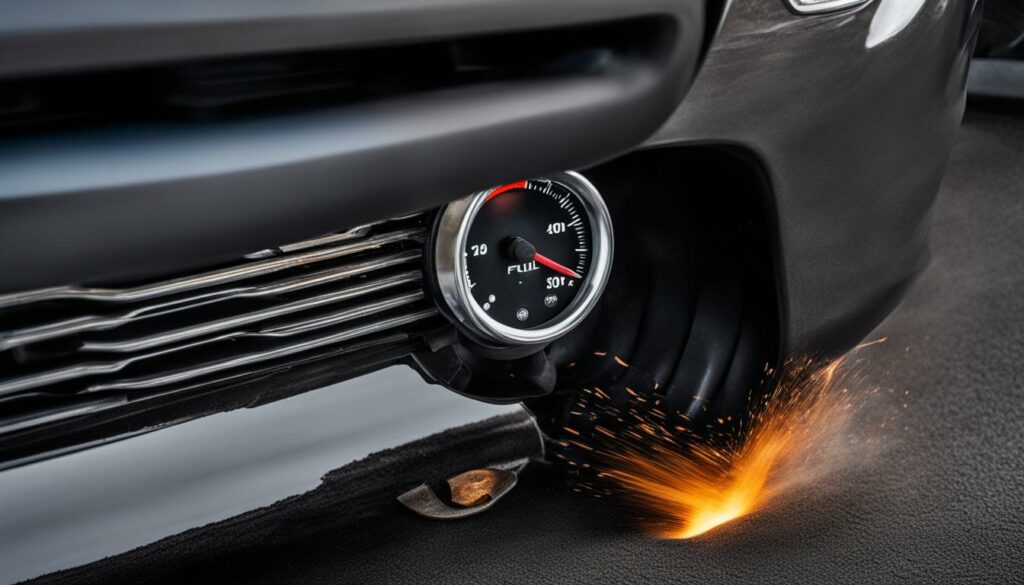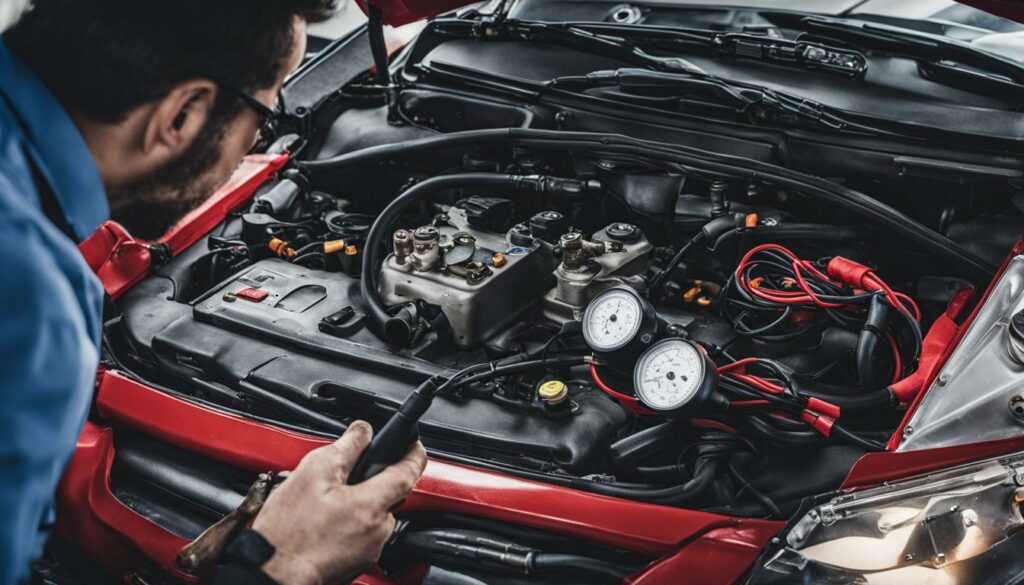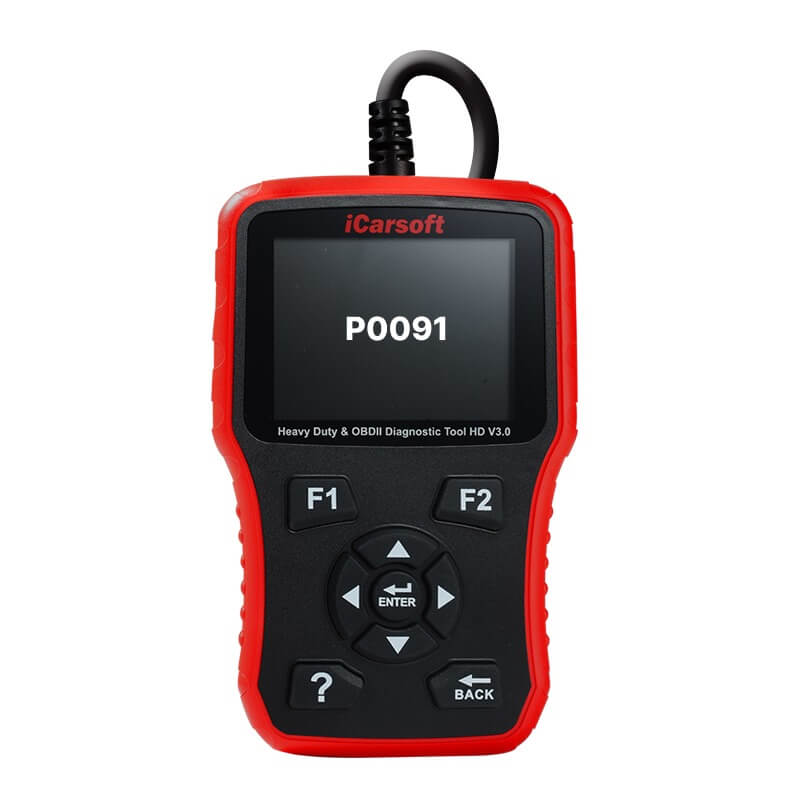P0091 – Fuel Pressure Regulator Control Circuit Low
POSTED IN pcodes
Welcome to our article on the P0091 code, which relates to the fuel pressure regulator control circuit. If you’ve encountered this code or are simply looking to learn more about it, you’ve come to the right place. In this article, we’ll provide a technical description of the code, explain its meaning and severity, discuss common symptoms and causes, outline troubleshooting steps, and cover the necessary repairs. So, let’s dive in and explore everything you need to know about P0091 and how it affects your vehicle’s fuel system, engine performance, and fuel efficiency.
Symptoms of the P0091 Code
The P0091 code can cause several symptoms in your vehicle. It’s important to be aware of these symptoms, as they can indicate a potential issue with the fuel pressure regulation.
Delayed Startup
If you experience a delayed startup, especially when the engine is cold, it could be a sign of the P0091 code. This delayed startup occurs because the low fuel pressure affects the engine’s ability to start smoothly.
Black Smoke Emission
Another symptom of the P0091 code is black smoke emission from the exhaust system. This black smoke is a result of an improper air-fuel mixture, caused by the low fuel pressure. If you notice excessive black smoke coming from your vehicle’s exhaust, it’s essential to have the issue addressed.
Reduced Fuel Efficiency
Reduced fuel efficiency is a consequence of the engine not receiving the optimal amount of fuel. If you observe a decrease in your vehicle’s fuel efficiency and find yourself refueling more frequently, it could be due to the low fuel pressure associated with the P0091 code.
Buy tested tuning file for Adblue / EGR / DPF / Adblue off now!
Engine Misfires
Engine misfires can also occur as a result of the P0091 code. When the fuel pressure is not at the correct level, it can disrupt the combustion process and lead to engine misfires. If you feel a noticeable loss of power or your engine is running rough, it’s crucial to have the issue diagnosed and repaired.

| Symptoms of the P0091 Code | |||
|---|---|---|---|
| Delayed Startup | Black Smoke Emission | Reduced Fuel Efficiency | Engine Misfires |
Causes of the P0091 Code
The P0091 code can be triggered by several factors that affect the fuel delivery system in your vehicle. Understanding these causes is crucial to effectively diagnose and resolve the issue. The following are common causes of the P0091 code:
- Faulty Fuel Pump: A malfunctioning fuel pump may fail to provide the necessary fuel pressure, leading to low fuel delivery to the engine.
- Fuel Pump Relay Failure: If the fuel pump relay is faulty, it can disrupt the power supply to the fuel pump, resulting in inadequate fuel pressure.
- Defective PCM: A defective Powertrain Control Module (PCM) can hinder its ability to regulate the fuel pressure regulator, leading to low fuel pressure.
- Electric Fuel Pressure Regulator Issues: When the electric fuel pressure regulator malfunctions, it can cause insufficient fuel pressure.
- Fuel System Restriction: Restrictions in the fuel system, such as a clogged fuel filter or fuel lines, can impede the flow of fuel, resulting in low fuel pressure.
- Wiring Damage: Damaged wiring, such as a short to ground, can disrupt the communication between fuel system components, impairing fuel pressure regulation.
- Low Fuel Levels: Insufficient fuel levels in the fuel tank can lead to low fuel pressure.
Identifying the specific cause of the P0091 code requires a thorough diagnosis of your vehicle’s fuel system. By addressing these potential causes, you can effectively resolve the P0091 code and restore optimal fuel delivery and engine performance.
Diagnosis of the P0091 Code
The diagnosis of the P0091 code involves several steps to identify the cause of the low fuel pressure. A mechanic will start with a visual inspection of the fuel system components, such as the fuel tank, pump, filter, lines, hoses, electrical wiring, connectors, sensors, and injectors. This thorough inspection aims to uncover any damages or issues that may be affecting fuel pressure.
After the visual inspection, a fuel pressure test is performed to assess the functionality of the fuel system sensors and ensure the fuel pressure is within the specified range. To monitor the fuel system data, a mechanic may use a fuel pressure gauge and a diagnostic scanner. The readings obtained are then compared to the fuel pressure specifications provided by the vehicle manufacturer.
If any discrepancies are found during the fuel pressure test, further diagnosis is necessary to pinpoint the faulty components or circuits. Circuit testing with a digital volt/ohmmeter (DVOM) is utilized, following the manufacturer’s recommended procedures for testing the electronic fuel pressure regulator and individual fuel pressure regulator control circuits. It is essential to check power supply relays, fuses, and grounds as part of the diagnosis process.
By conducting a comprehensive diagnosis, including visual inspection, fuel pressure test, and circuit testing, the mechanic can accurately determine the root cause of the P0091 code. This detailed analysis provides the foundation for effective repairs and resolution of the issue.
Common Mistakes in Diagnosing the P0091 Code
When it comes to diagnosing the P0091 code, there are some common mistakes that mechanics should avoid. One of these mistakes is replacing the fuel pressure regulator or fuel pump without confirming that they are actually faulty. It is important to note that a trouble code, such as the P0091 code, is simply an indication of a sensor reading that is out of specification. Assuming that the mentioned part is the culprit without conducting a thorough diagnosis can lead to unnecessary part replacements and wasted time and effort.
To avoid this mistake, it is crucial to perform a complete and thorough diagnosis of the fuel system. This includes conducting a visual inspection of the fuel system components, such as the fuel tank, pump, filter, lines, hoses, electrical wiring, connectors, sensors, and injectors. Visual inspection can help identify any obvious damages or issues that may be causing the low fuel pressure indicated by the P0091 code.
Furthermore, it is essential to perform fuel pressure testing and circuit testing to identify the true cause of the low fuel pressure. This involves using a fuel pressure gauge and diagnostic scanner to monitor the fuel system data and compare it with the fuel pressure specifications provided by the vehicle manufacturer. By relying on factual data rather than assumptions or preset interpretations of the trouble code, mechanics can accurately diagnose the P0091 code and address the specific issue causing the low fuel pressure.
By taking the time to conduct a thorough diagnosis, mechanics can avoid the common mistake of replacing the fuel pressure regulator or fuel pump without confirmation. This ensures that they are addressing the actual cause of the P0091 code, leading to effective repairs and optimal engine performance.

Key Mistakes to Avoid:
- Replacing the fuel pressure regulator or pump without confirmation
- Not conducting a thorough diagnosis of the fuel system
- Relying on assumptions or preset interpretations of the trouble code
| Mistake | Consequence | Solution |
|---|---|---|
| Replacing the fuel pressure regulator or pump without confirmation | Unnecessary part replacements, wasted time and effort | Perform a complete diagnosis of the fuel system, including visual inspection, fuel pressure testing, and circuit testing |
| Not conducting a thorough diagnosis of the fuel system | Failure to identify the actual cause of the low fuel pressure | Conduct a visual inspection of fuel system components and perform fuel pressure and circuit testing |
| Relying on assumptions or preset interpretations of the trouble code | Inaccurate diagnosis and ineffective repairs | Rely on factual data and follow diagnostic procedures |
By avoiding these common mistakes and following proper diagnostic procedures, mechanics can effectively diagnose and repair the P0091 code, ensuring optimal engine performance and fuel efficiency.
Severity of the P0091 Code
The P0091 code can have severe implications for engine performance, fuel delivery, and overall efficiency. The code indicates a low voltage signal from the control circuit of the electronic fuel pressure regulator, leading to a decrease in fuel pressure. This can result in various drivability issues and potential engine breakdown if left unaddressed.
Impact on Engine Performance
When the fuel pressure is low due to the P0091 code, it can cause delayed startup, stalling during acceleration, and a lack of power. The engine may struggle to start, requiring prolonged cranking or even failing to start altogether. These issues can greatly impact the overall performance and drivability of the vehicle.
Effect on Fuel Efficiency
The low fuel pressure caused by the P0091 code can result in poor fuel economy. With insufficient fuel being delivered to the engine, the vehicle may consume more fuel to compensate, leading to decreased fuel efficiency. Addressing the P0091 code is vital to restore optimal fuel delivery and improve overall fuel efficiency.
Risk of Engine Breakdown
Ignoring the P0091 code can have serious consequences, including the potential for engine breakdown. Insufficient fuel pressure can strain the engine, leading to increased wear and potential damage. In extreme cases, the engine may completely fail, leaving the driver stranded on the side of the road. It is crucial to address the P0091 code promptly to prevent further damage and costly repairs.
| Severity Level | Impact |
|---|---|
| High | – Delayed startup – Stalling during acceleration – Lack of power – Poor fuel economy – Risk of engine breakdown |
| Medium | – Reduced engine performance – Decreased fuel efficiency |
| Low | – Minor decrease in engine performance – Slight reduction in fuel efficiency |
The severity of the P0091 code should not be underestimated. It is crucial to have the issue diagnosed and repaired by a qualified technician to ensure proper fuel delivery, optimize engine performance, and maintain fuel efficiency. Ignoring the code can lead to further engine damage and more costly repairs in the future.
Conclusion
In conclusion, the P0091 code, which indicates a low voltage signal from the control circuit of the electronic fuel pressure regulator, can have significant effects on engine performance and fuel efficiency. Symptoms such as delayed startup, black smoke emission, reduced fuel efficiency, and engine misfires are common indicators of this code. To diagnose the issue, a thorough inspection of the fuel system components and circuit testing is necessary. Once the root cause has been identified, appropriate repairs such as replacing faulty components or repairing damaged wiring can be made. It is crucial to address the P0091 code promptly to prevent further engine damage and ensure optimal fuel delivery and efficiency. By following the correct diagnostic and repair procedures, mechanics can successfully resolve the P0091 code and restore the engine’s performance and fuel efficiency to their full potentials.
FAQ
What is the P0091 code and what does it mean?
The P0091 code is a diagnostic trouble code that indicates a low voltage signal from the control circuit of the electronic fuel pressure regulator. This code is stored in the Powertrain Control Module (PCM) and is related to the fuel pressure regulation in the fuel delivery system.
What are the symptoms of the P0091 code?
Symptoms of the P0091 code may include delayed startup, black smoke emission from the exhaust, reduced fuel efficiency, and engine misfires.
What are the common causes of the P0091 code?
Common causes of the P0091 code include a faulty fuel pump, fuel pump relay, PCM, electric fuel pressure regulator, fuel system restriction, damaged wiring, or low fuel levels.
How is the P0091 code diagnosed?
The diagnosis of the P0091 code involves a visual inspection of the fuel system components, a fuel pressure test to check the functionality of the fuel system sensors, and circuit testing to identify the faulty components or circuits.
What are some common mistakes in diagnosing the P0091 code?
One common mistake is replacing the fuel pressure regulator or pump without confirming that they are actually faulty. It is important to perform a complete diagnosis of the fuel system to identify the true cause of the low fuel pressure.
How severe is the P0091 code?
The P0091 code should be considered severe as it can cause various engine performance issues, and if left unaddressed, it can lead to engine breakdown and more expensive repairs.
What is the key takeaway about the P0091 code?
The P0091 code indicates a low voltage signal from the control circuit of the electronic fuel pressure regulator. It can cause engine performance issues and should be diagnosed and repaired promptly to ensure proper fuel delivery and efficiency.


